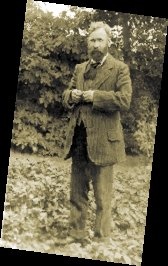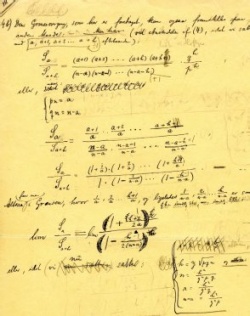The Bashful Genius
01. Nov. 2007

Erlang in the open, 1915
Post & Tele Museum
Erlang's Tables
The name of Erlang will probably evoke recognition among elderly readers who remember his logarithmic tables from the mathematics lessons at school. Today calculators have superseded the tables in education, but those of us who used to swot up difficult calculations have probably often thought kindly of Erlang. And even today we have a lot to be grateful to him for.
A Hard-Working Student
Erlang was born in 1878 in the village of Lønborg in Western Jutland, the youngest son of the local school teacher. Already at an early age Erlang showed unusual talents - he was a quiet child who preferred bulky books on mathematics to playing and who was capable of understanding very complex problems expeditiously.
After elementary school he moved to Hillerød to study at Frederiksborg State School and finally, in 1901, he graduated in the faculties of Science from the University of Copenhagen with mathematics as his main subject.
Dedicated as Erlang was to the world of mathematics, bashful and distant he appeared among others. He never married, but lived with his sister Ingeborg in Copenhagen all his life.

Segment of Erlangs hand-written calculations.
Post & Tele Museum
The Father of Traffic Theory
Erlang worked as a teacher for a couple of years, but his life changed all of a sudden in 1908 when the visionary director of the Copenhagen Telephone Company Ltd., Frits Johannsen, headhunted the young mathematician. As the scientist of the telephone company Erlang was to research how the company could obtain a reasonable balance between the costs of new installations and the service to be offered to the subscribers. Erlang engaged eagerly in the work and in 1917 he presented his so-called B-formula - the gibberish of the introduction - which in short calculates the dimensioning of the telephone network that secures the smoothest and most effective operation of telephone calls.
With his revolutionary formula Erlang founded the modern traffic theory that we are all benefiting from today. The B-formula is used to work out optimal traffic scenarios in many contexts - from making new roads and how to streamline postal services, to how many check-out counters should be open in the supermarket. So remember Erlang gratefully next time you drive a car, send a letter, or go shopping.
Erlang's Archives
The B-formula soon made a sensation in professional circles with the result that in 1946 the international unit of teletraffic measurement got the name "erlang". If among our readers somebody may have become interested in the achievements of the number cruncher, the museum's library disposes of Erlang's archives. They contain his records, calculations, drawings etc. and have subsequently been supplemented with literature on teletraffic.
This article may be copied or quoted with MuseumsPosten, Post & Tele Museum as source.
Comment this article
Only serious and factual comments will be published.